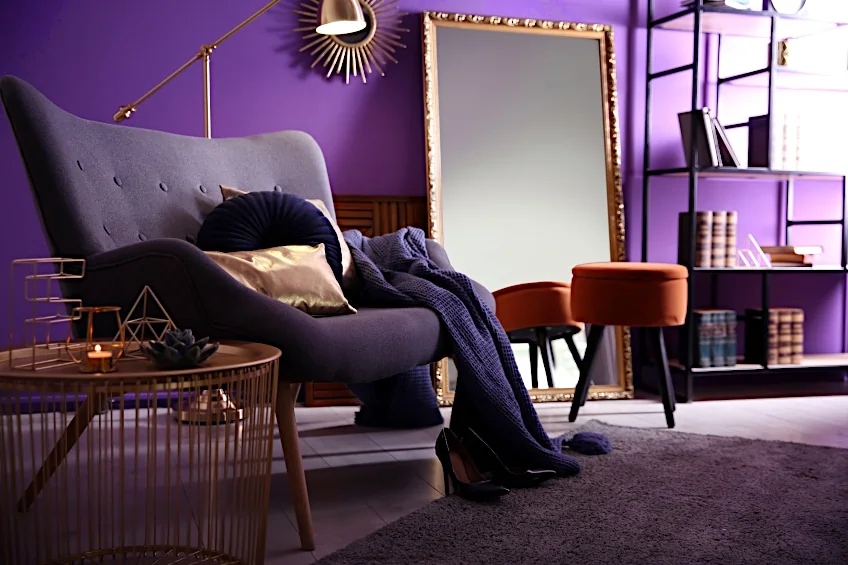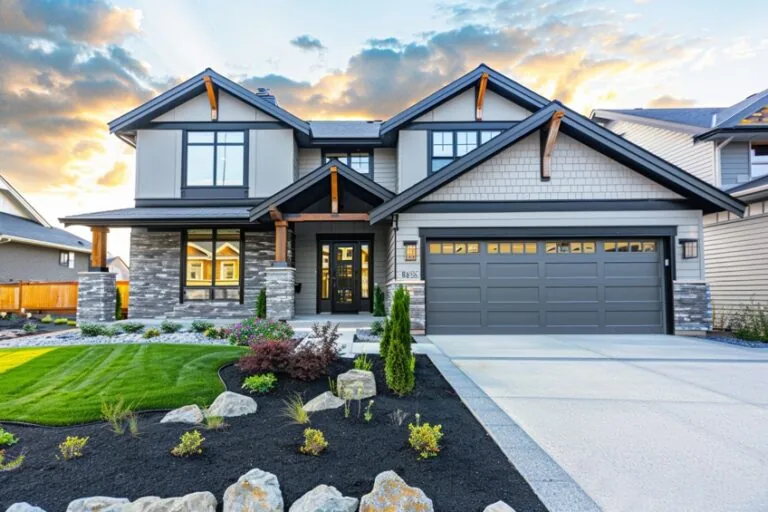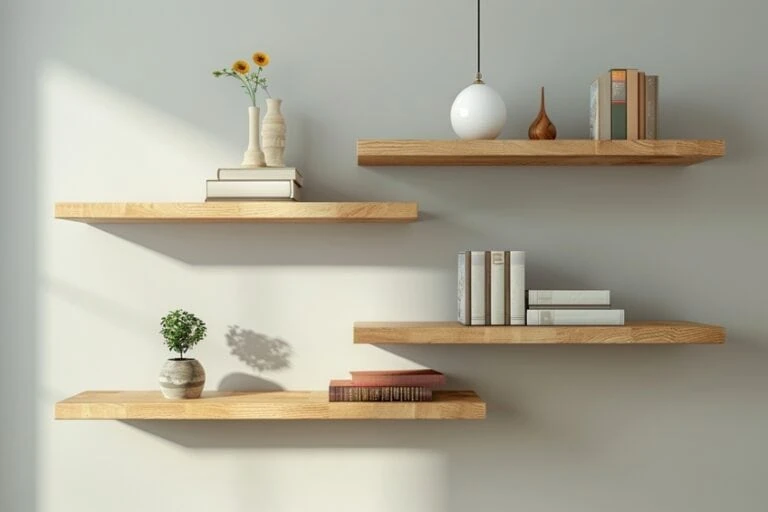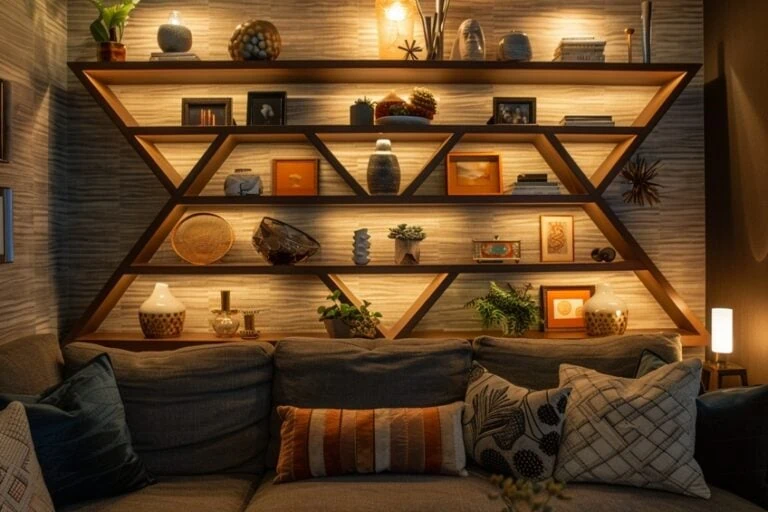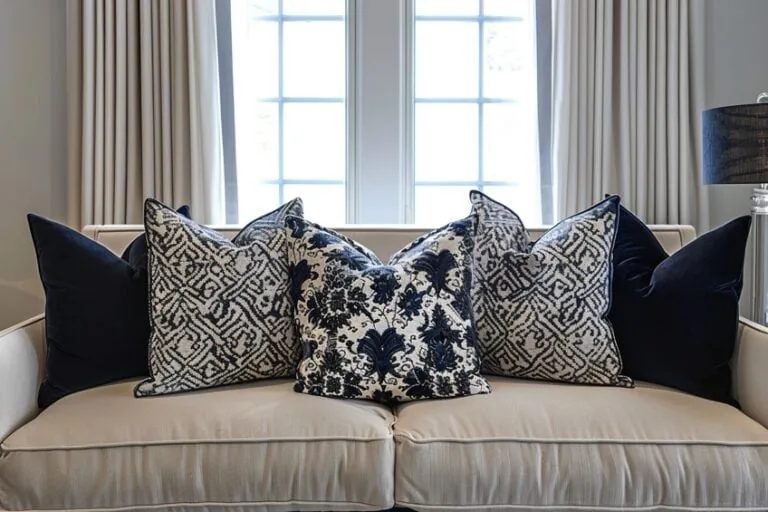What Colors Go With Purple? – How to Showcase Shades of Purple
This post may contain affiliate links. We may earn a small commission from purchases made through them, at no additional cost to you.
Purple might not be the first color you consider when decorating your home, as it may seem to be challenging to work with. However, many colors go with purple, and it is quite a versatile color. Depending on what shade of purple you choose, it can transform a room into something inviting and exceptional.
Purple Color Combinations
The best color combination with purple might surprise you, as you can pair purple with virtually any color. However, there needs to be a balance in the colors you choose, otherwise, it can become too moody or produce a feeling that is not what you are looking for. Purple is an even mixture of blue and red, however, there are countless shades of purple, which is what makes it so versatile.
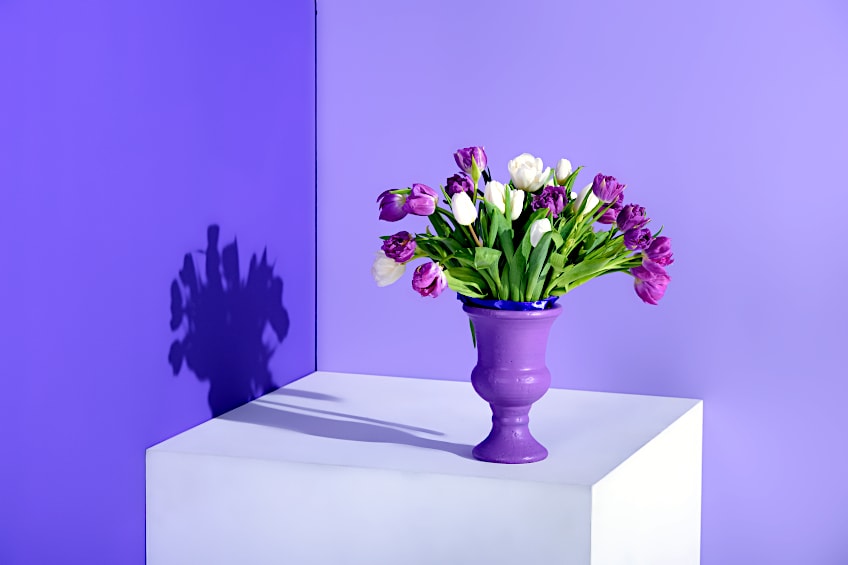
Purple contains the passion of red and the strength and calmness of blue. As with all colors, purple also has meaning. The color is associated with royalty, luxury, creativity, dignity, independence, and wisdom. However, it also has associations with darkness, mysticism, and audaciousness, which is why some people find it difficult to work with. To create the best color combination with purple, it is a good idea to learn a bit more about color theory.

Color Theory and the Color Purple
To create the most appealing purple color combinations, you need to recognize how colors work together. You can do this by looking at a basic color wheel. A color wheel has all the colors like your primary, secondary, and intermediary colors placed in a visual circle shape.
When you look at the position of the colors, you will see that on one side you have your reds, yellows, and orange colors, which are considered warm colors. On the opposite side of the color wheel, you have your blues, and greens, which are seen as your cooler colors. This is known as your color temperature of color bias.
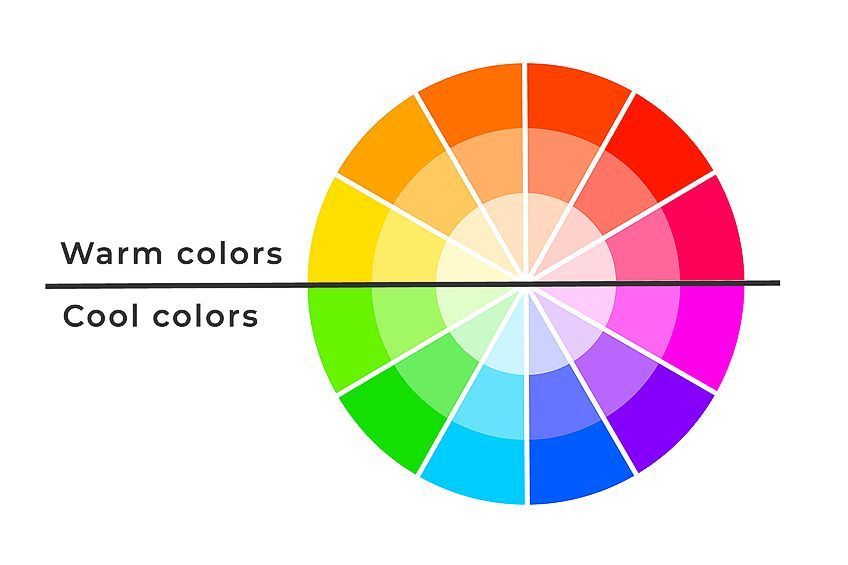
Since purple contains red and blue, various shades of purple can be found closer to the blue side or the red side. For example, let us choose violet. You can get a violet-blue or you can get a violet-red since violet itself sits in the middle of red and blue. Below are a few color combination terms you may want to look into when you create a purple color scheme.
| Shade of Purple | Hex Code | CMYK Color Code (%) | RGB Color Code | Purple Color |
| Violet | #ee82ee | 0, 45, 0, 7 | 238, 130, 238 | |
| Violet-Red | #f75394 | 0, 66, 40, 3 | 247, 83, 148 | |
| Violet-Blue | #324ab2 | 72, 58, 0, 30 | 50, 74, 178 |
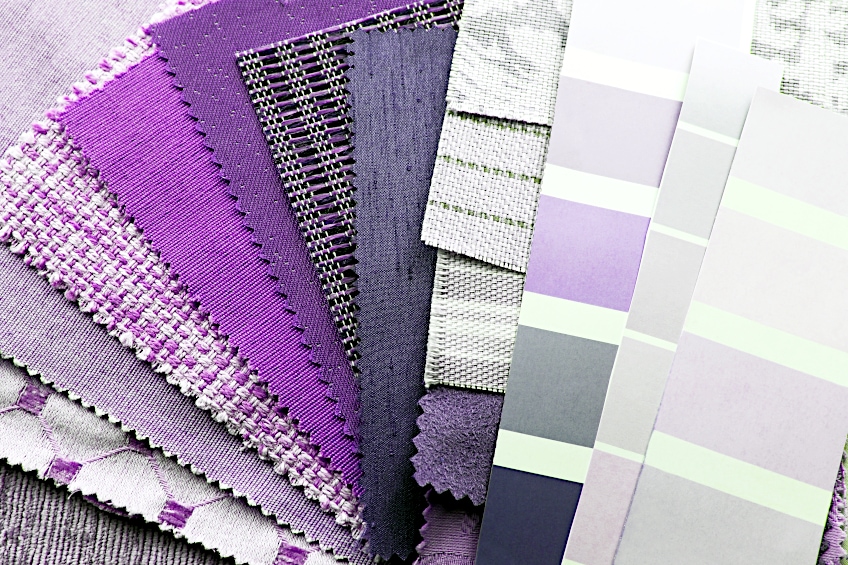
Purple Complementary Colors
Complementary colors go well when paired together, as they help each other stand out or contrast one another. This balance of colors is achieved by pairing purple with complementary colors like orange, yellow, and green. These colors sit on the opposite side of the color wheel, yellow being the color to complement purple the best. However, when dealing with the color wheel, complementary colors are not the only color combinations you can create.
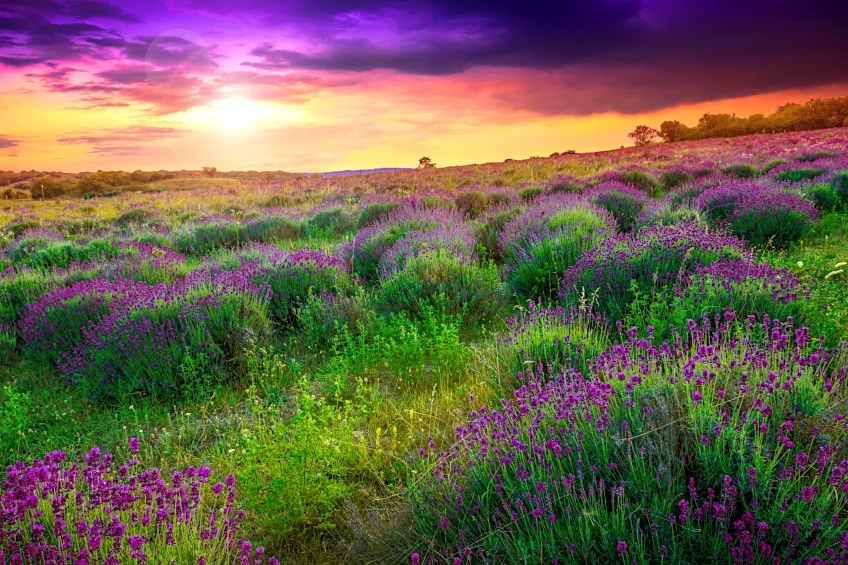
There is another combination that can fall into this category, which is known as a split complementary color combination. Choose your main color, in this case, purple, and then find the complementary color, which is yellow. Your split complementary colors will lay on each side of the yellow. The colors, in this case, will be yellow-green and yellow-orange.
| Shade | Hex Code | CMYK Color Code (%) | RGB Color Code | Color |
| Purple | #800080 | 0, 100, 0, 50 | 128, 0, 128 | |
| Yellow | #ffff00 | 0, 0, 100, 0 | 255, 255, 0 | |
| Yellow-Green | #9acd32 | 25, 0, 76, 20 | 154, 205, 50 | |
| Yellow-Orange | #ffae42 | 0, 32, 74, 0 | 255, 174, 66 |
Analogous Colors
Analogous colors are found alongside one another on the color wheel and work harmoniously when paired together. So, if you choose your main color, like purple, the colors that will be best for this color combination are red-purple and blue-purple, and all the shades of color that lay within this range.
| Shade of Purple | Hex Code | CMYK Color Code (%) | RGB Color Code | Purple Color |
| Purple | #800080 | 0, 100, 0, 50 | 128, 0, 128 | |
| Red-Purple | #953553 | 0, 64, 44, 42 | 149, 53, 83 | |
| Blue-Purple | #8a2be2 | 39, 81, 0, 11 | 138, 43, 226 |
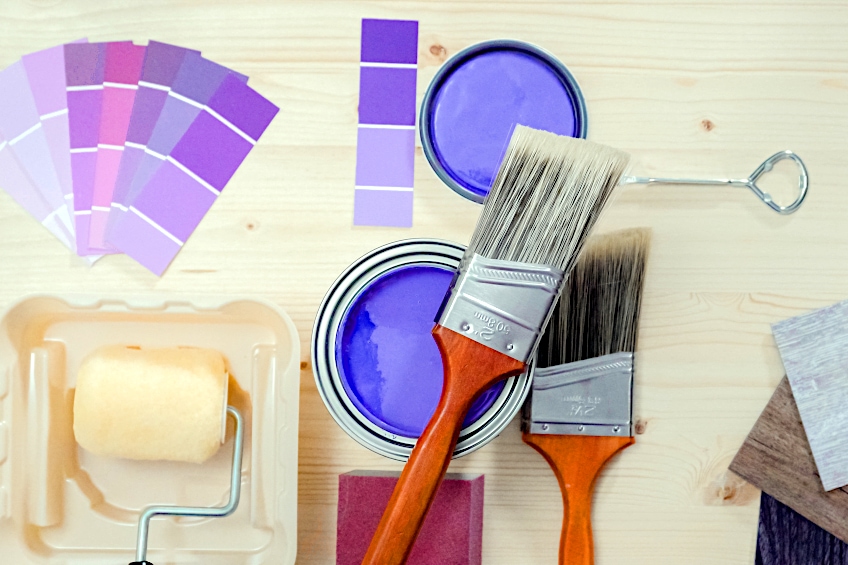
Monochromatic Colors
This type of color scheme is perfect if you just want to stick with the purple color. You then take the purple color and use assorted tints and shades of the same color. When working with a monochromatic purple color palette, you can combine it best with your neutral colors like white, brown, gray, and black. The table below has an example of this type of color combination.
| Shade of Purple | Hex Code | CMYK Color Code (%) | RGB Color Code | Purple Color |
| Purple | #800080 | 0, 100, 0, 50 | 128, 0, 128 | |
| Dark Purple | #340034 | 0, 100, 0, 80 | 52, 0, 52 | |
| Light Purple | #cd00cd | 0, 100, 0, 20 | 205, 0, 205 |
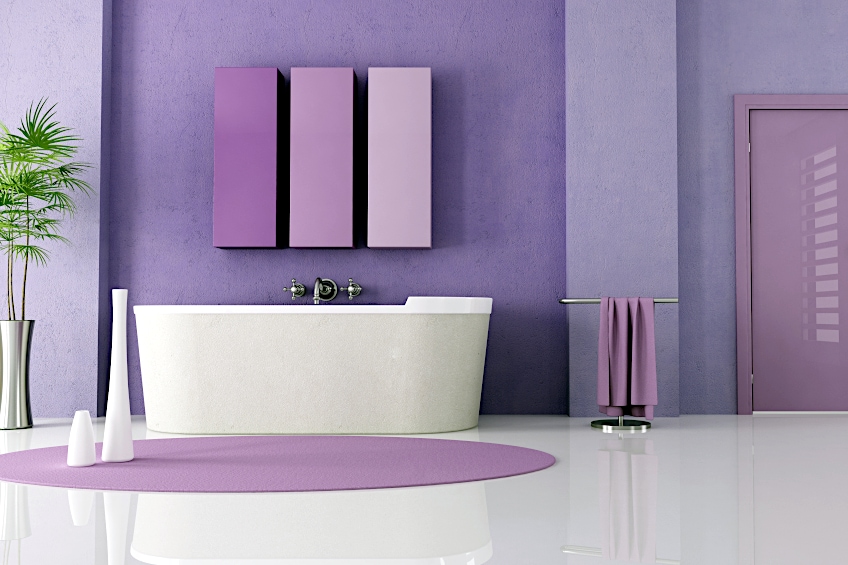
Triadic Colors
As the name suggests, you choose colors that form an even-sided triangle when looking at the color wheel. When using purple as one of your colors, the other two colors for this color scheme will be green and orange. This combination brings in a little more warmth and energy.
| Shade | Hex Code | CMYK Color Code (%) | RGB Color Code | Color |
| Purple | #800080 | 0, 100, 0, 50 | 128, 0, 128 | |
| Green | #00ff00 | 100, 0, 100, 0 | 0, 255, 0 | |
| Orange | #ffa500 | 0, 35, 100, 0 | 255, 165, 0 |
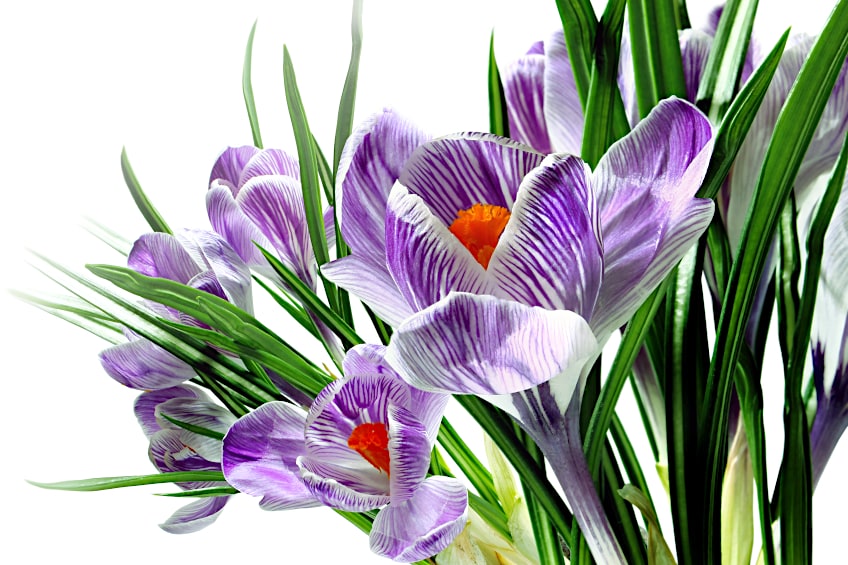
Interior Design and Colors That Go With Purple
Purple is a fun color and there are many ways you use it to create amazing purple color schemes. Understanding how colors work together can be a great help in creating a more balanced look. What colors go with purple? Generally, purple works best with yellow, orange, green, brown, white, black, and gray. However, the various shades of purple can also have different color matches that work best. Purple color schemes also depend on what style you are going for and what room you are going to decorate.
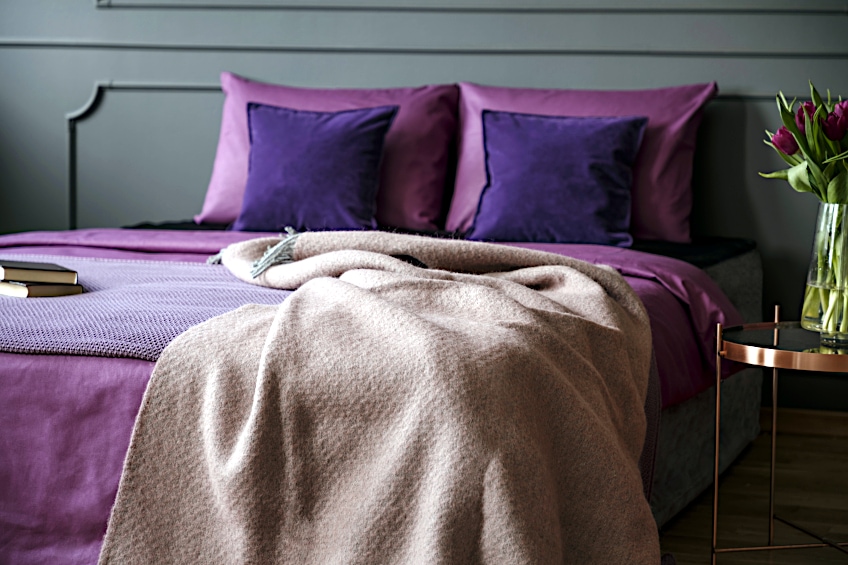
Since the various shades of purple can be warm or cool, you need to always be aware of the paint color undertones, so that you pair the colors properly. If you are a bit wary of working with purple, you can easily stick to more subtle choices. For example, keep your purples soft and pair them with white.
Purple colors like lavender, lilac, and pastel shades, tend to be more feminine and provide a relaxing and calming feel. So, these colors are ideal for rooms like the bedroom, where you want a more calming ambiance.
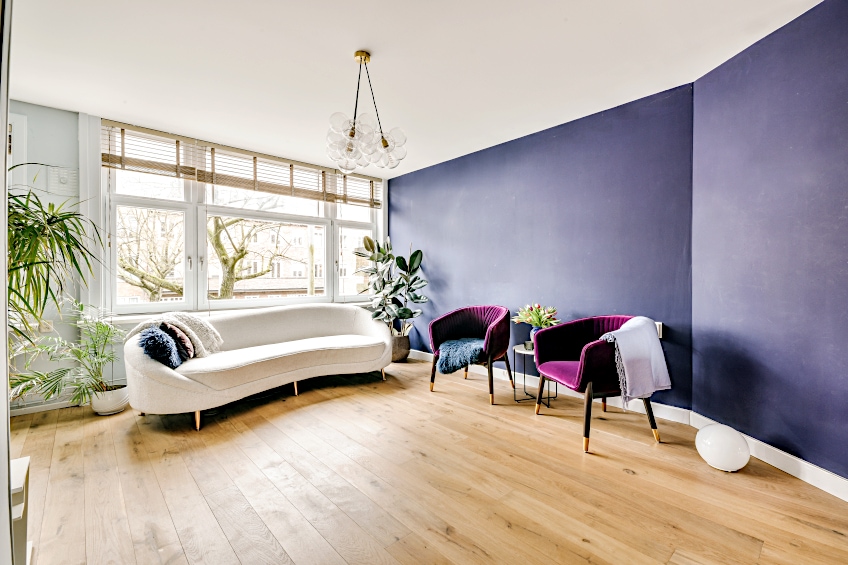
Too much darker purple can become somber, so these colors need to be alongside complementary colors to brighten the mood. Also, using brighter and bolder purples as accent colors can bring in color without being overwhelming. Purple can be used in many ways, including the following.
- Some may say that purple is too much on walls, but it can be done. However, less is usually better and lighter shades are a safer Darker or more vibrant purples can rather be used as accent colors or, if you want to paint the walls, do so in a room that receives more light.
- You can even paint the ceiling purple if you wish, but again, the shade of purple you choose is important. Using darker shades will make a room feel smaller and cozier, and lighter shades will make a smaller room feel larger.
- If you are afraid to paint the walls and ceiling, bring purple into a room using accents of color. These can be shades of purple furniture, lampshades, pillows, throws, curtains, or rugs.
- Make use of different colors and create a purple color palette with no more than three colors if you want to keep it simple enough. Two colors are even easier to work with. Choose your main color and then use the others as your accent colors for purple.
- Include contrasting colors, for example, if you choose purple as your main color, add contrasting colors or accent colors for purple in the rugs and furniture. You can also consider patterns and different textures.
- Consider various shades of purple. This can help to add depth and balance to a room. For example, when using a lighter shade on the walls, take darker shades and use them as your focus point.
- When choosing paint, select a lighter shade. This is because the paint can appear more saturated when painted on the walls. Natural light and artificial light sources should also be considered when choosing a color.

Purple and Green
This color combination is a natural choice, as there are a few examples that you can see in nature, for example, lavender flowers. When using a green and purple color palette, it is best combined with a light beige, cream, white, or shades of gray, to provide a more balanced or natural look.
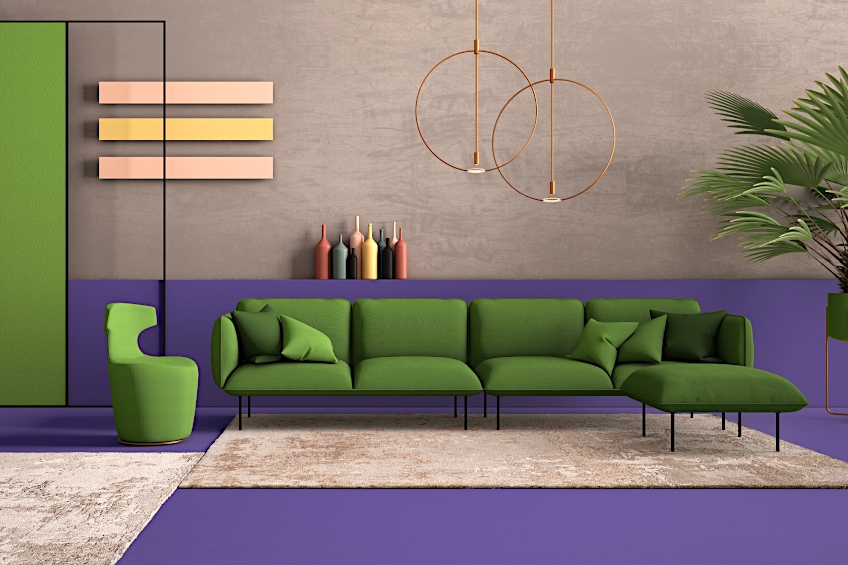
You can also experiment with different shades of both green and purple from deep purples and dark greens to bright greens and more vibrant purples. Some examples include aubergine and lavender, forest green, and mint.
You can either go for lavish purple color schemes, where you use shades of purple and accent colors for purple, or use purple as your accent color. This can be done for a living area or even in the bedroom for a fresh, yet calming look. Below are some examples of darker and lighter shades of both purple and green.
| Shade | Hex Code | CMYK Color Code (%) | RGB Color Code | Color |
| Aubergine | #693b58 | 0, 44, 16, 59 | 105, 59, 88 | |
| Lavender | #967bb6 | 18, 32, 0, 29 | 150, 123, 182 | |
| Forest Green | #014421 | 99, 0, 51, 73 | 1, 68, 33 | |
| Mint Green | #3eb489 | 66, 0, 24, 29 | 62, 180, 137 |
Purple and Yellow
Since yellow is the complementary color of purple, they work well together and are usually a popular choice for both interior design as well as fashion design. Looking for a regal, more stylish look, try pairing a deeper shade of purple with mustard yellow. To make the look even more extravagant, try adding textures like velvet.
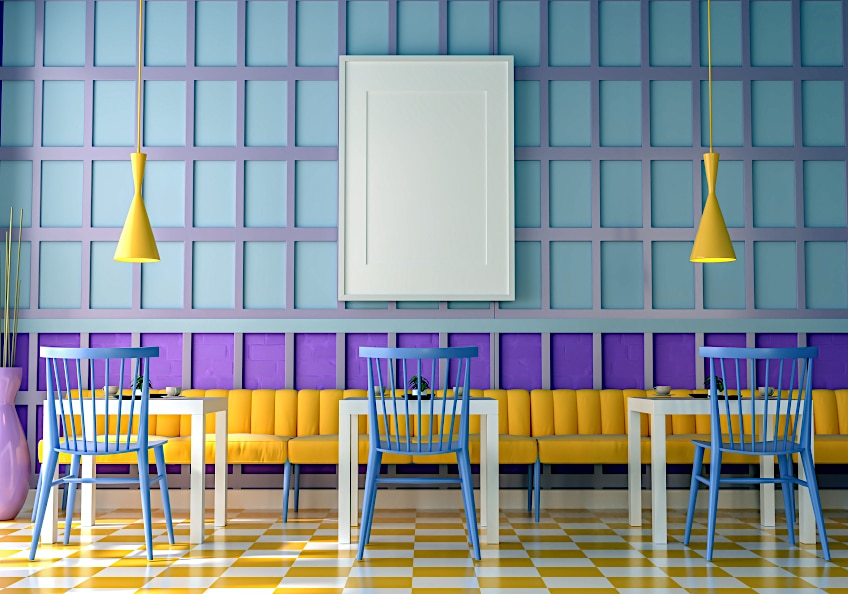
A combination that is a little more fun includes lilac purple with a paler, pastel yellow. This combination can also be used in a child’s bedroom, and you can bring these colors in by using patterned checkered or flower fabrics. Include white as your third color to help balance the look.
| Shade | Hex Code | CMYK Color Code (%) | RGB Color Code | Color |
| French Lilac | #86608e | 6, 32, 0, 44 | 134, 96, 142 | |
| Mustard Yellow | #ffdb58 | 0, 14, 65, 0 | 255, 219, 88 | |
| Lilac | #c8a2c8 | 0, 19, 0, 22 | 200, 162, 200 | |
| Pastel Yellow | #fdfd96 | 0, 0, 41, 1 | 253, 253, 150 |
Purple and Blue
You have a lot of different shades of blue, each of which can work beautifully with purple. A darker blue like navy can work well with a lighter shade of gray and a dark purple. You could also work with bolder colors like royal blue, and pair this with a lighter shade of purple. In a room, the walls can be painted a lighter shade of purple, while the royal blue is brought in as an accent color.
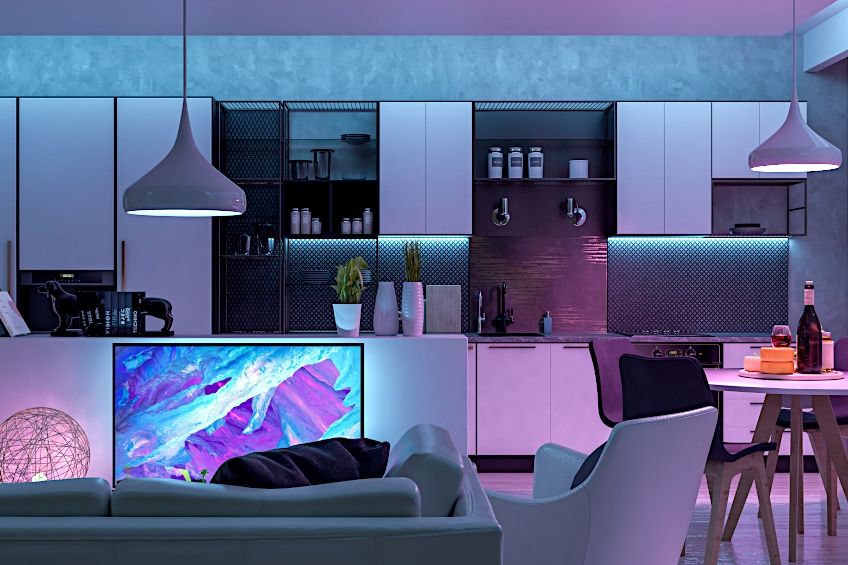
Lighter blues that are paired with more vivid purples, provide a more conventional look that remains fresh, calming, and comfortable. The more vibrant colors can be used as accent colors to a more neutral background.
| Shade | Hex Code | CMYK Color Code (%) | RGB Color Code | Color |
| Navy Blue | #000080 | 100, 100, 0, 50 | 0, 0, 128 | |
| Dark Purple | #4e2a84 | 41, 68, 0, 48 | 78, 42, 132 | |
| Light Gray | #e7ecf6 | 6, 4, 0, 4 | 231, 236, 246 |
| Shade | Hex Code | CMYK Color Code (%) | RGB Color Code | Color |
| Light Shade of Purple | #e8e1e9 | 0, 3, 0, 9 | 232, 225, 233 | |
| Royal Blue | #4169e1 | 71, 53, 0, 12 | 65, 105, 225 |
| Shade | Hex Code | CMYK Color Code (%) | RGB Color Code | Color |
| Orchid | #da70d6 | 0, 49, 2, 15 | 218, 112, 214 | |
| Light Blue | #add8e6 | 25, 6, 0, 10 | 173, 216, 230 |
Purple and Black
Black is a color that can add contrast without clashing and it can work well with most colors. Adding black does not have to involve using excessive amounts, you could simply add in black doorknobs, black frames, or other fixtures. A couch or table could have black metal elements or a lampstand can have a black base.
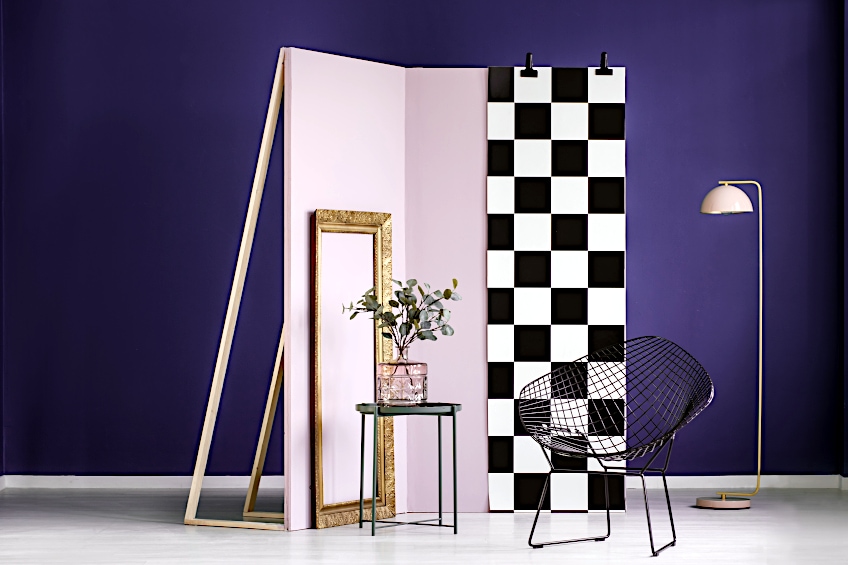
Purple and black go well together and including a third color like pale pink or a shade of gray can bring a little more stability to the look, especially if it is a darker shade of purple. When using color, try using the 60-30-10 method, where you choose your main color, which involves using 60 percent of your main color, which is purple, within a color scheme. You will then use 30 percent pink, and 10 percent black. You could also include accessories that come in various shades of purple and pink, for example, throws and pillows.
| Shade | Hex Code | CMYK Color Code (%) | RGB Color Code | Color |
| Lavender | #967bb6 | 18, 32, 0, 29 | 150, 123, 182 | |
| Black | #000000 | 0, 0, 0, 100 | 0, 0, 0 | |
| Light Pink | #ffeaed | 0, 8, 7, 0 | 255, 234, 237 |
Purple and Orange
Purple and orange alone are bold colors, so you might feel a bit wary of combining these two options. However, purple and orange can work quite well together. You can try going for purple walls and adding in an orange couch. To be more conservative, create a neutral background and bring in purple and orange accents by using pillows and throws, or bring in the colors within the furniture fabric itself. Even a piece of artwork can bring these vibrant colors into a room.

| Shade | Hex Code | CMYK Color Code (%) | RGB Color Code | Color |
| Purple | #5500cc | 58, 100, 0, 20 | 85, 0, 204 | |
| Orange | #cc5500 | 0, 58, 100, 20 | 204, 85, 0 |
Maybe you have not even considered purple as a color for your home, because you are not sure how to use it with other colors? However, you can create some amazing purple color schemes and there are endless ways you can incorporate the color without it being too overwhelming.
Frequently Asked Questions
What Colors Go With Purple?
Even though purple may seem difficult to work with, the color is quite versatile and can be paired with many colors. However, some of the more popular colors include yellow, orange, green, gray, white, black, and other shades of purple.
What Is the Best Purple Complementary Color?
The best colors that complement purple, would first be yellow but the various shades of green and orange also provide great contrast. These colors would sit on the color wheel and face each other on opposite sides.
Does Purple Work With Silver and Gold?
Various shades of purple can work extremely well with both silver as well as gold. The gold adds a warmer tone, while silver can help to bring out the cooler tones of purple. This color combination can easily work in living rooms and bedrooms. You could even experiment in a bathroom or office setting.
Does Brown Go With Purple?
Yes, brown is one of the many colors that go with purple. You can use either color as your neutral background, for example, a light mauve, or add in accents of both these colors as a focal point in a neutral room. This is where you can bring in beautiful wood pieces or leather furniture, for example, mahogany chairs can work well with the light mauve background. However, there are many different shades of both colors you can experiment with.

